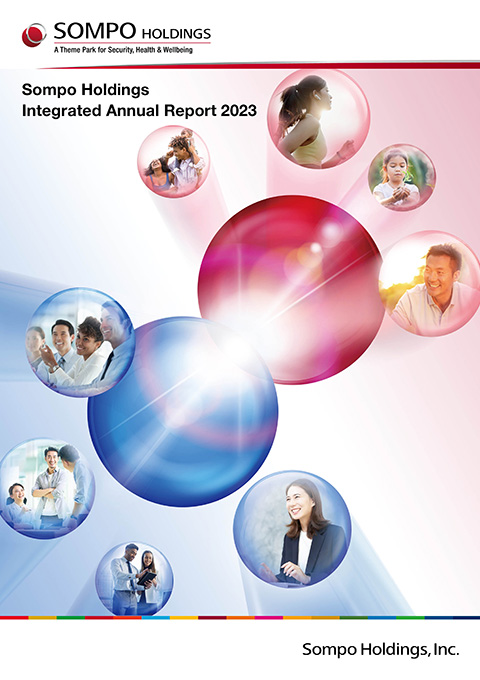 Making the Data Business a Reality
Making the Data Business a Reality
Future of Nursing Care Realized by the Nursing Care Real Data Platform “egaku”
In Horizon 2 of its digital strategy, we will develop new businesses by utilizing various data accumulated through DX. Since the Real Data Platform concept was first proposed, we have been making Group-wide efforts to implement it. Finally, the service was launched as “egaku” in 2023.
This section presents a discussion on the topic of “egaku” and the future of nursing care between Ken Endo, CEO of the Nursing Care & Seniors Business, who is leading the realization of Horizon 2 with “egaku” and Tsuneya Matsuyama, President and Representative Director of ND Software, which is participating in this ecosystem as a partner.

Ken Endo
CEO of Nursing Care & Seniors Business
Tsuneya Matsuyama
President and Representative Director ND Software
Background of the development of “egaku”
Endo In Japan, the demand for nursing care will continue to rise steadily due to the increase in the number of people requiring nursing care as the population ages. Meanwhile, the working-age population, including those who provide nursing care, will continue to decline. According to an estimate by Japan’s Ministry of Health, Labour and Welfare, the gap between labor supply (personnel providing nursing care) and demand (from seniors in need of nursing care) is expected to expand to 690,000 by 2040.
Japan’s nursing care system is a wonderful system unparalleled in the world, with various types of services, including facility-based and home-based services, arranged all over the country, from Hokkaido to Okinawa. My concern is that such a system will become unsustainable due to the widening gap between the supply of caregivers and the demand for them.
The development of “egaku” was driven by the desire to do something about this situation and to provide an ecosystem to save nursing care in Japan.
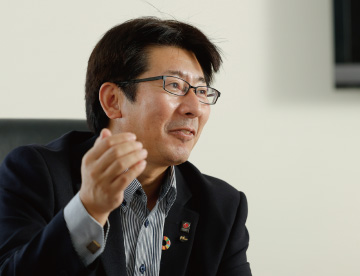
Matsuyama ND Software contributes to the sound operation of nursing care providers and supports the nursing care insurance system by providing software for office management and on-site operational support, with a focus on nursing care and welfare. Closing the gap between supply and demand for caregivers is a very important issue that we must address.
We need to increase the appeal of the nursing care industry, which has to compete with other industries for talent. Otherwise, the gap between supply and demand for caregivers may expand beyond the estimate from Japan’s Ministry of Health, Labour and Welfare. As for how to increase the appeal of the nursing care industry, these four improvements are necessary: staff compensation, job satisfaction, quality of care, and productivity. And the key to these improvements is the use of IT and digital technologies. I believe that “egaku” will enable us to “visualize” nursing care, leading to better staff compensation, job satisfaction, and improvement in quality and productivity of care.
Data-driven ecosystem
Endo It is said that there are 60,000 nursing care providers in Japan, but the market share of the five largest companies, including ours, is about 3%, so it’s an industry dominated by small and medium-sized businesses. We are working to expand our facilities and business sites, but simply expanding the size of our company is not enough to change the entire nursing care industry and revolutionize the future of nursing care in Japan.
However, Sompo Care has daily record data for 80,000 clients and more than 20,000 employees—in other words, real big data. Analyzing this data will surely reveal something. If we can use this data to help our clients, and if we can build and provide an ecosystem for our efforts in the nursing care industry, I believe we can change nursing care in Japan. With this in mind, we decided to proceed with detailed investigations.
That’s when the partnership with Palantir started and the Real Data Platform (RDP) concept was launched.
Matsuyama ND Software, like the Sompo Group, is a company that has been pursuing “Security, Health & Wellbeing” in nursing care and disability welfare facilities. Our goal is to use our system to support nursing care and disability welfare facilities to achieve “Security, Health & Wellbeing” for our clients. And our employees are strongly motivated to pursue happiness not only for businesses that use our system but also for more nursing care and disability welfare facilities and clients. This is perfectly aligned with the Sompo Group’s Purpose.
We were the first software company to join the Sompo Group. I believe that by joining the Group, getting involved in actual business operations, and providing solutions that utilize real data, we can help increase productivity, profitability, staff compensation, and job satisfaction, as well as increase recruitment and reduce turnover. This will help communicate the value of new solutions created by a partnership between companies with real data and IT, DX, and software companies. If more and more IT, DX, and software companies around the world say, “we want to work with SOMPO,” I think this will lead to transformation in those industries too, not just the nursing care industry.
Value created by “egaku”
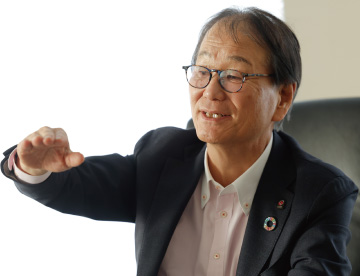
Endo Our plan for “egaku” calls for net sales of 30 billion yen and operating profit of 10 billion yen by fiscal 2030. Another important thing is the social value that “egaku” creates.
We estimate that by closing the supply-demand gap of about 220,000 caregivers, “egaku” can generate social value of about 3.7 trillion yen by 2040, and we aim to achieve that goal.
And as “egaku” increases productivity, this will free up resources to improve the compensation of all employees working in the nursing care industry. The ultimate goal is to increase the appeal of the nursing care industry by creating this kind of virtuous cycle throughout the industry.
To this end, we will make “egaku” the de facto standard in the industry. In other words, I believe that if we can reach the point where nursing care providers can’t imagine losing access to “egaku,” we can bring about a major change in the industry.
Matsuyama From my perspective, the great thing about “egaku” for nursing care sites, which currently rely on paper records and where data exists in different places, is that it a system that transforms their paperwork-centered operations into data-driven, operation-centered management.
The on-site management know-how accumulated up to now can be converted into data, and this data can be used to improve operations and care services. There is also the issue that some nursing care recipients and their families see a lack of respect for their wishes when they look at the current way of doing things. There are many providers who want to move away from the uniformity of care, where services are left to the whims of the providers and everyone receives the same services.
The “egaku” system can support the operation of such nursing care, greatly contributing to the ideal in which each person is able to receive the nursing care he or she wants.
For example, the data on the time spent on care might show that person A receives above-average care, while person B receives below-average care. This observation could indicate that person A might be receiving excessive care, potentially hindering their independence, while person B might not be receiving enough care. This kind of analysis makes it possible to provide individualized care tailored to each person’s needs. Nursing care that has traditionally depended on the intuition and experience of individual staff members can be “visualized” and linked to operations. This is the great thing about “egaku.”
Endo I agree with you. To give an example of what “egaku” can do, if a facility has 70 clients, for example, 70 names will appear on the screen, and their weekly time spent on care can be viewed in comparison to the standard time spent on care. This means that we can see at a glance which clients are requiring more than the standard amount of time spent on care. These cases may be relevant to assistance with eating or going to the toilet. For example, in the case of assisting with bowel movements, maybe you go to their room but find that they aren’t ready to go yet, or maybe you discover they are suffering from incontinence.
In short, there may be many reasons why the time spent on care is out of sync. Once the cause of the problem is identified, a solution can be found, such as shifting the time of day for bowel movements. What used to be locked away in the minds of the staff now becomes visible, and you can see the whole picture.
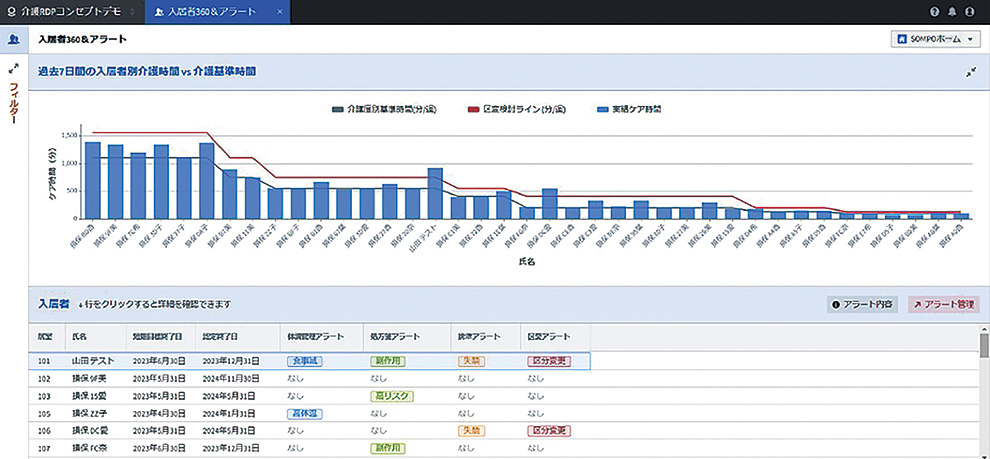
Matsuyama In some cases, staff can even hinder their client’s independence. For example, maybe a staff member is helping you change your clothes, when you could manage it by yourself in 30 minutes. This can also be visualized by “egaku,” which can improve the quality of care by enabling individualized care. With “egaku” we can provide care that respects the dignity of the individual and is tailored to the wishes of the client.
Endo When Sompo Care approaches facilities that provide uniformity of care, we advise them to change this style of operation. We encourage them to adopt “egaku” to visualize the nursing care provided at their facility and help them switch to personalized care.
Response to “egaku”
Endo The early adopters outside of Sompo Care are implementing “egaku” so that management can increase productivity while not compromising the quality of care, which will ultimately lead to more efficient staffing and improved compensation. They understand the need for this and what it will take to make it happen.
When “egaku” is deployed in the field, home directors, staff, and other front-line nursing care workers must change their existing operations. Resistance to this change is the challenge. It is important that each person on site understands what it is we are doing and why we are doing it. To that end, the first priority is to create a large number of “success stories.”
As you can imagine, our own facilities are the ones that are responding the best right now. They use “egaku” a lot. Home managers, care conductors, and others in leadership roles have a strong sense of its usefulness. The next step is to bring the rest of the staff on board. It is important to spread and deploy it in a way that makes people feel motivated and comfortable working with it.
I believe that increasing the number of these success stories outside of Sompo Care is the most important way to spread “egaku” throughout the industry, so we are now working on the goal of introducing “egaku” at 100 business sites in fiscal 2023.
Also, although many establishments in Japan have installed software for handling nursing care insurance claims, competition for nursing care record systems is fierce, making it a battle over the user-friendliness of each system. Looking ahead to the future development of “egaku,” my hope is that ND Software will increase our advantage in nursing care record systems and increase the synergies with “egaku.”
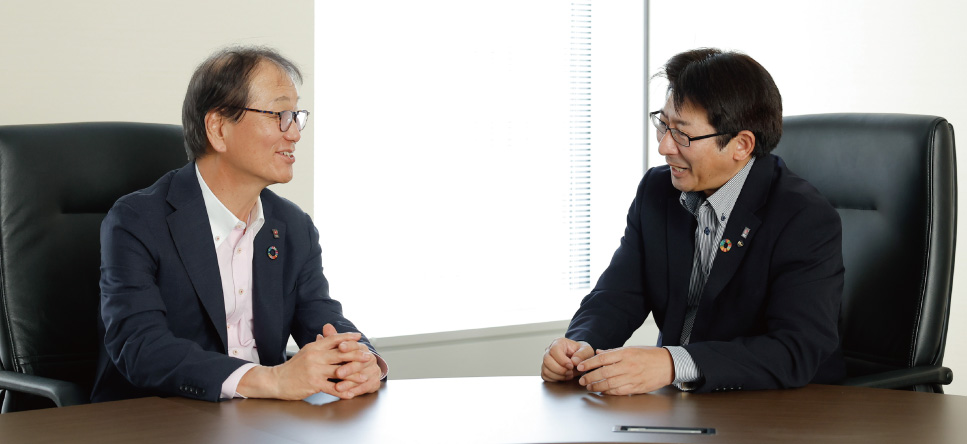
Future prospects
Endo Fiscal 2023 will be a very important year. As I mentioned earlier, our challenge is to expand the number of businesses that are happy they introduced “egaku.”
ND Software has a high market share in specialty nursing homes, and I believe that if we succeed in making a case for using “egaku” there, deployments will accelerate.
It’s not enough for Sompo Care to say that our system is good; the most important thing is that people hear it from other companies in the same industry, which will be the engine for promoting “egaku.”
In addition, many people receive nursing care at home, not in institutions. How to introduce “egaku” there is the next challenge. In a facility, we can collect data 24 hours a day, 365 days a year, but we have contact with people who receive nursing care at home only a few times a week.
Currently, smart cities and special digital health zones are being developed all over Japan. This is a healthcare data platform that connects medical and nursing care led by local governments. These platforms are created by the local governments, and the data is gathered there. Deploying “egaku” there is the key to success in the home-based sector.
Some local governments have already started collaborating with us. There are also local governments that started collaborating with Sompo Japan Insurance as a result of the regional cooperation agreements that Sompo Japan Insurance is promoting across Japan. Local governments in Japan are facing serious problems of aging and declining population. I think they can benefit from effective use of technologies like our recently launched “Care-ale,” a new smartphone app we developed for home-based care that makes it easy to share physical conditions and daily events.
By improving the productivity of the nursing cares business, “egaku” enables everyone to receive nursing care. As a result, fewer people will need to leave work in order to care for their relatives, and even if the number of nursing care staff does not increase, we can still contribute to closing the supply-demand gap of caregivers, which is a major social issue, and generate social value of about 3.7 trillion yen. I want to make this a reality.
Matsuyama ND Software aims to become the software company that can best support nursing care and disability welfare facilities in Japan in order to solve the problem of nursing care in Japan. What we need to do specifically is to bundle our current software with “egaku”; in other words, to create a system that works well with “egaku.” In particular, we aim to use our nursing care records system to acquire a variety of data from the field and build a system that can improve operations.
We are determined to do our best to contribute to reducing the burden on nursing care sites, thereby improving the productivity of the entire nursing care industry and the sustainability of the outstanding nursing care insurance system that Japan is so proud of.
Endo Our medium- to long-term challenge is to expand overseas. Supporting overseas nursing care providers in their business operations through “egaku” is one way to do this. In particular, we are seriously considering providing education and training know-how.
The “egaku” system is based on real data, and some regions have strict regulations on acquiring personal information overseas, but I hope we can overcome these problems and provide the world with value that only SOMPO can offer and that only SOMPO can deliver.
